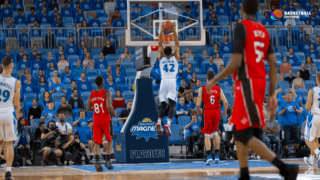
Calling all basketball enthusiasts! Get ready for an adrenaline-fueled ride as we dive into the exhilarating world of the Run and Gun offense in basketball. This fast-paced and highly entertaining playing style is an offense-lover’s dream come true. In this blog post, we’ll be breaking down the electrifying Run and Gun strategy, its impact on the game, and why it has fans on the edge of their seats. Featuring lightning-fast breaks, dazzling ball movement, and high-scoring affairs, it’s time to sprint your way into the heart of this thrilling offensive strategy. Are you ready to fast-break the mysteries of the Run and Gun offense? Let’s hit the court and get started!
What’s a Run and Gun Offense in Basketball?
A Run and Gun offense in basketball is a fast-paced offensive strategy that prioritizes quick transitions, continuous ball movement, and early shot attempts. It aims to capitalize on the opponent’s defensive vulnerabilities by rapidly advancing the ball down the court, often within a few seconds, to create scoring opportunities before the defense can fully set up. This style of play emphasizes speed, athleticism, and excellent teamwork to effectively exploit scoring chances and keep the opposition off-balance.
Embracing the Need for Speed: Run and Gun Origins
The Run and Gun offense has roots dating back to the early days of basketball. Paul Westhead, the former head coach of the Los Angeles Lakers and the Denver Nuggets, was widely known for implementing this rapid-paced style. It took center stage in the basketball world in the 1970s and ’80s when NBA teams began adopting the game’s high-energy, action-packed style.
While initially met with skepticism, the Run and Gun offense has proved to be an effective and popular approach, with teams like the Phoenix Suns and the Golden State Warriors fully embracing the concept. The Run and Gun offense has since influenced various teams at different levels of basketball, including collegiate and international play.
Breaking Down the Run and Gun Offense Components
Quick Transitions
The Run and Gun offense begins with an unwavering focus on quick transitions. Fast breaks are the cornerstone of this offensive style, with teams looking to exploit scoring opportunities by moving the ball rapidly down the court. By capitalizing on turnovers and missed shots, a team can significantly increase the pace of the game, leaving their opponents scrambling to catch up.
Continuous Ball Movement
A key aspect of the Run and Gun offense is maintaining constant ball movement. Rather than relying on isolation plays or post-ups, this offensive strategy emphasizes fluid passing and quick decision-making. Ball movement helps to create open shot opportunities and catches the defense off guard, maximizing a team’s efficiency and scoring potential.
Early Shot Attempts
When playing within the Run and Gun system, it’s important not to hesitate when taking shots. Early shot attempts are an essential component of this offensive style, encouraging players to use their athleticism, speed, and shooting ability to take advantage of the defense before they can set up properly. Particularly effective from three-point range, early shots can increase a team’s scoring output dramatically when executed successfully.
Key Features Defining the Run and Gun Offense Success
Athleticism and Physical Fitness
Inherent in the fast-paced nature of the Run and Gun offense is the need for players to maintain peak physical fitness. This offensive strategy requires exceptional speed, endurance, and agility from its practitioners. Athleticism is a significant asset, allowing players to seamlessly cover the court, create open shots, and outpace the opposition on both offense and defense.
Skilled Shooters and Opportunistic Scorers
The success of the Run and Gun offense is dependent on both accurate shooters and opportunistic scorers. As players often take early shots, it’s crucial to have personnel skilled in perimeter shooting, particularly from beyond the arc. Furthermore, an effective Run and Gun offense benefits from players proficient at finishing at the rim and capitalizing on transition opportunities.
High Basketball IQ and Decision-Making
Given the fast-paced nature of the Run and Gun offense, players must possess a high basketball IQ and effectively make split-second decisions. Remaining composed under pressure and accurately assessing rapidly changing court dynamics are essential for players looking to implement this strategy. Quick decision-making capabilities allow players to capitalize on defensive weaknesses, creating efficient shot selection and fewer turnovers.
Game-Changing Advantages of the Run and Gun Offense
Disrupt Defense and Increase Scoring Opportunities
By pushing the tempo and adopting an up-tempo style, the Run and Gun offense can disrupt the opposition’s defense, leaving them vulnerable and scrambling to cover the court. This fast-paced game plan can increase a team’s scoring opportunities and limit contested shot opportunities, maximizing their efficiency on the offensive end.
Fatigue the Opposition
The furious pace of the Run and Gun offense can eventually take a toll on even the most athletic opponents. This offensive approach can tire out opposing players, leading to mental and physical fatigue, ultimately contributing to poor decision-making and slower reaction times. Capitalizing on this fatigue factor, the Run and Gun offense allows teams to impose their will on opponents and establish a dominant tempo.
Exciting and Crowd-Pleasing
From a spectator standpoint, the Run and Gun offense provides an exhilarating viewing experience. High-scoring, fast-paced games with frequent highlight-worthy plays draw the attention of basketball fans everywhere. By implementing an uptempo style, basketball teams can engage their audience and create memorable moments on the court.
Challenges of Implementing the Run and Gun Offense
Requires the Right Combination of Personnel
While the Run and Gun offense boasts numerous advantages, it also presents unique challenges. Perhaps most notably, this offensive strategy requires the right combination of personnel – players who can keep up with its frenetic pace and perform consistently in the face of immense pressure. This might limit the effectiveness of the Run and Gun offense for teams with plodding big men or players lacking in court-stretching shooting skills.
Potential Defensive Shortcomings
The lightning-fast pace of the Run and Gun offense can result in defensive shortcomings, as the focus often remains confined to the offensive end. Transition defense may suffer when players become fully committed to constantly pushing the pace, making it difficult for teams to balance both offensive and defensive aspects of their game. This can be seen as a trade-off, with the potential for higher scoring but the risk of conceding points in return.
Greater Risk of Fatigue and Injuries
As mentioned earlier, the fast pace of the Run and Gun offense demands peak physical fitness, exposing players to tiredness and elevating the risk of fatigue-related injuries. Additionally, since success relies on speed, agility, and quickness, any significant injury to key players can severely hinder a team implementing the Run and Gun offense.
Adding the Run and Gun Offense to Your Playbook: How to Get Started
Excited by the prospect of implementing the Run and Gun offense in your own basketball game or coaching instruction? Follow these steps for a smooth integration:
- Assess team personnel: Start by evaluating your team, considering each player’s strengths, physical fitness, and overall skillset. Assess whether your team’s composition is suitable for the Run and Gun offense and how it can be adapted or improved upon.
- Emphasize physical conditioning: Invest time in enhancing player’s physical conditioning, with a focus on speed, strength, and endurance to better cope with the increased tempo and physical demands of the Run and Gun offense.
- Practice feverishly: Implement high-intensity drills, focusing on transition play, quick ball movement, and early shooting opportunities. Establish team chemistry and ensure players understand the ins and outs of the Run and Gun offense through rigorous practice sessions.
- Develop mental fortitude: Foster a high basketball IQ and strong decision-making skills in your players. Encourage them to maintain composure under pressure and work collectively to identify weaknesses in the opposition’s defense.
By following these steps, you can begin to incorporate the Run and Gun offense into your basketball toolbox, creating a high-energy, exciting, and – if executed correctly – highly effective playing style that can win games and please crowds.
In Conclusion: Unleashing the Power of the Run and Gun Offense
While the Run and Gun offense presents its fair share of challenges and requires the right personnel, it remains an attractive and highly effective strategy when successfully implemented. Its ethos of speed, athleticism, and rapid ball movement can unsettle defenses and provide teams with a potent scoring weapon.
By understanding the essentials of the Run and Gun offense, teams of all skill levels can begin to harness its incredible potential, elevating their basketball game to dizzying new heights. So, grab your sneakers, hit the court, and embrace the thrill of the Run and Gun offense!
Mastering Essential Drills for Run and Gun Offense
To maximize the potential of your Run and Gun offense, it’s vital to focus on essential drills that help develop skills specific to this playing style. The following drills will sharpen your team’s athleticism and quick thinking, both crucial for success in this fast-paced approach.
Three-Man Fast Break Drill
One of the most effective drills for simulating the Run and Gun offense, the Three-Man Fast Break Drill encourages teamwork and speed in transitioning from defense to offense. Players practice taking quick outlet passes and pushing the ball down the court, striving for lay-ups or open jump shots within seconds.
Transition Shooting Drills
These drills prepare players for the early shot opportunities found in the Run and Gun offense. They can include drills like dribble hand-offs, rapid passing sequences, and catch-and-shoot scenarios. The primary goal is to build confidence and accuracy in shooting from different positions on the court while on the move.
Defensive Reaction and Recovery Drills
Given the Run and Gun offense’s emphasis on rapid transitions and continuous play, it’s essential to develop balance between offense and defense. Defensive reaction and recovery drills focus on forcing turnovers, communicating effectively, and seamlessly switching between offense and defense. This can include full-court press exercises and rapid trapping scenarios that help build team cohesion and adaptability.
Endurance Training and Conditioning
Physical conditioning is vital for anyone looking to excel in the Run and Gun offense. Incorporate drills designed to enhance overall endurance, speed, and strength. Examples include sprints, shuttle runs, and circuit training workouts that target a player’s cardiovascular fitness and muscular development. Make sure to schedule regular rest periods and recovery sessions to ensure your players don’t become overwhelmed or injured.
Emulating Successful Run and Gun Teams and Players
Following in the footsteps of successful Run and Gun practitioners can provide invaluable insights into mastering this offense style. By studying game footage of NBA teams like the “Seven Seconds or Less” Phoenix Suns, coached by Mike D’Antoni, or Steve Nash and Amar’e Stoudemire’s offensive synergy, learn the finer points of this approach and how to refine your team’s execution.
Similarly, observing well-rounded players like Steph Curry of the Golden State Warriors, who excel at quick decision-making, shooting, and passing, can inspire your players to push their own limits within the Run and Gun system.
Remember, the key to success with the Run and Gun offense is discipline, practice, and teamwork. Invest time and effort into instilling these qualities in your players, and you’ll be well on your way to embracing the high-octane and exciting world of the Run and Gun offense in basketball.
FAQs: Run and Gun Offense in Basketball
If you’re curious about the ins and outs of the Run and Gun offense in basketball, this FAQ section is for you! Browse through the most commonly asked questions about this high-energy offensive strategy and learn everything you need to know to elevate your understanding of the game.
1. Is the Run and Gun offense suitable for youth teams?
Yes, the Run and Gun offense can be suitable for youth teams, provided they possess the necessary athleticism, endurance, and skillset. Teams should adapt the offensive strategy to fit their players’ abilities and emphasize the fundamentals of quick ball movement, transition play, and early shots.
2. How can a slower-paced team effectively counter the Run and Gun offense?
To counter the Run and Gun offense, a slower-paced team can focus on controlling the tempo of the game. This includes executing deliberate half-court offensive sets, prioritizing defensive rebounding, and quickly returning to set up on defense to minimize transition opportunities for the Run and Gun team.
3. Can a team combine the Run and Gun offense with other strategies?
Yes, a team can combine the Run and Gun offense with other strategies, creating a versatile and dynamic game plan. The key is to maintain balance and adapt to different game situations, choosing the most appropriate approach to exploit the opposing team’s weaknesses.
4. How important is defense in the Run and Gun offense?
While the Run and Gun offense prioritizes fast breaks and scoring, defense remains essential. Teams should strive for balance between the two, developing a well-rounded game that includes forced turnovers, effective communication, and consistent defensive effort to complement the fast-paced, high-scoring offense.
5. What is a “Seven Seconds or Less” offense?
The “Seven Seconds or Less” offense, coined during Mike D’Antoni’s tenure as the Phoenix Suns head coach, refers to a subset of the Run and Gun offense. The strategy aims to score within seven seconds of gaining possession, emphasizing rapid transitions, quick ball movement, and early shot attempts.
6. How does a Run and Gun offense work in a half-court setting?
In a half-court setting, the Run and Gun offense can involve quick passing, off-ball movement, and rapid cuts to exploit the defense. It still focuses on executing early shot attempts, emphasizing players’ agility, floor spacing, and accurate shooting to create efficient scoring opportunities.
7. Is the Run and Gun offense only for professional basketball teams?
No, the Run and Gun offense can be applied to any level of basketball, including collegiate, high school, and recreational leagues. Players and coaches can adapt the strategy to their playstyles and team composition, aiming to capitalize on rapid transitions and high-energy play.
8. Can a team with dominant post players effectively use the Run and Gun offense?
Yes, a team with dominant post players can adapt the Run and Gun offense by incorporating their big men into fast break situations, emphasizing quick post-ups or mid-range shots. These players can also focus on rebounding and outlet passing to initiate fast breaks for their teammates.
9. What are the ideal player characteristics for the Run and Gun offense?
Key attributes for players in the Run and Gun offense include speed, athleticism, high basketball IQ, accurate shooting, endurance, and adaptability. Effective players possess strong decision-making skills and excel in various aspects of the game, from ball-handling to finishing at the rim.
10. How does the Run and Gun offense affect overall team morale?
When executed well, the Run and Gun offense can boost team morale by generating high-scoring games and fast-paced, exciting gameplay. The emphasis on quick transitions and team play fosters camaraderie, leading to shared enthusiasm and increased on-court success.
11. What can be the risks of utilizing the Run and Gun offense?
Some risks associated with the Run and Gun offense include defensive vulnerabilities, susceptibility to fatigue and injuries, and the potential for high turnovers. These risks can be managed through efficient execution, regular conditioning, and establishing a balance between offensive and defensive game tactics.
12. Which NBA coaches are known for utilizing the Run and Gun offense?
Coaches known for utilizing the Run and Gun offense include Paul Westhead, Mike D’Antoni, Don Nelson, and Doug Moe. They have achieved varying degrees of success with this fast-paced, high-scoring approach by tailoring it to their respective team’s skill sets and strengths.
13. How does a Run and Gun offense adapt to different game situations?
A Run and Gun offense can adapt to different game situations by varying the tempo, selectively implementing half-court sets, or focusing on defensive strategies. An adaptable team utilizes its skills effectively, while maintaining the essence of rapid pace and continuous ball movement to exploit opponents’ weaknesses.
Featured Posts
- No pillar pages found.





